
Hard disk drives on computers and portable devices like laptops have been there for a very long time now, and is still being used by many users worldwide. On the other hand, the adoption of faster solid-state drives are increasing quickly as well, thanks to it the cost of the drives coming down compared to before, and of course, the lower failure rate compared to HDDs. While the biggest advantage of SSDs is the speed and performance, it wasn’t quite matching up to the levels of HDDs in terms of capacity. That started changing as well with QLC (Quad-level cell that stores four bits per cell) SSDs which enabled manufacturers to bring higher storage capacity drives. Compared to three bits per cell on the TLC (Triple-Level cell) SSDs.
Micron 5210 ION was the world’s first QLC SSD that was launched back in 2018 and Samsung also launched its first QLC SATA SSD the same year – Samsung 860 QVO in 1TB, 2TB, and 4TB storage sizes. Fast-forward to 2020, and Samsung recently launched its 2nd Gen QLC SSD – Samsung 870 QVO V-NAND SSD in 1TB, 2TB, 4TB, and a whopping 8TB storage capacity. We have been using the 2TB 870 QVO SSD for quite some time now, and in this review, let us see how it has improved over the last-gen and what new it brings to the table.
Specifications – Samsung 870 QVO
| Capacity |
1TB, 2TB, 4TB, 8TB
|
| Interface |
SATA 6 Gbps Interface, also compatible with SATA 3 Gbps & 1.5 Gbps interfaces
|
| Controller |
Samsung MKX Controller
|
| Form Factor | 2.5″ |
| Memory |
Samsung V-NAND 4-bit MLC (QLC)
|
| DRAM Cache Memory |
Up to 8GB LPDDR4; 2GB LPDDR4 on the 2TB model
|
| Sequential Read | Up to 560 MB/S |
| Sequential Write | Up to 530 MB/S |
| Random Read |
Up to 98,000 IOPS
|
| Random Write |
Up to 88,000 IOPS
|
| TeraBytes Written (TBW) |
Up to 2880 TB; 720 TB on the 2TB model
|
| Features |
TRIM (Required OS support), Garbage Collection, S.M.A.R.T
|
| Security |
AES 256-bit Full Disk Encryption, TCG/Opal V2.0, Encrypted Drive (IEEE1667)
|
| Warranty |
3 years or TBW, whichever comes first
|
Design
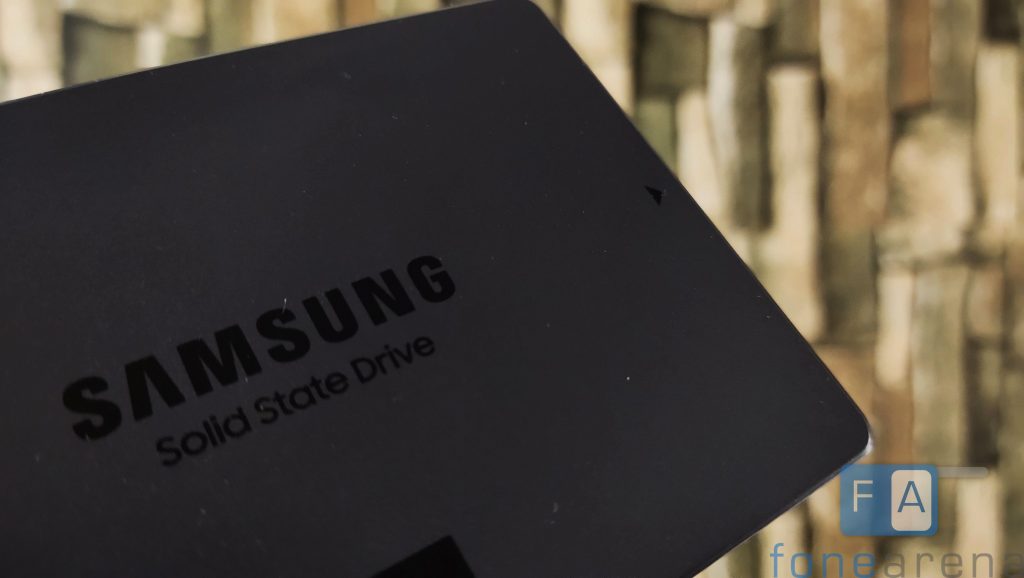
The 870 QVO Solid State Drive (SSD) sports a textured dark grey finish similar to its previous generation albeit this one has a slightly darker tone than the 860 QVO. This V-NAND SSD comes in a 2.5″ form factor with SATA 6 Gb/s interface and is also compatible with SATA 3 Gb/s and SATA 1.5 Gb/s interface. Samsung has used all-metal casing for this SSD which gives it an edge over its competitors that has a plastic casing.

Weighing at approximately 570 grams and 7mm thin, the 870 QVO doesn’t feel bulk and at the same time, doesn’t feel cheap either. The build quality of this solid-state drive is solid (pun intended) and is well-built, overall. There is a black arrow indication on the front which helps you in inserting the SSD in the 2.5″ SATA slot rightly. On the back, as with any 2.5″ V-NAND SSD, there are 15-pins for Power and 7-pins for Data, and you’ll find the Serial Number, Model Number, WWN (World Wide Name) unique identifier, power rating among others. On the whole, as for the design is concerned, the 870 QVO has a simple, minimalistic look to it.
Performance
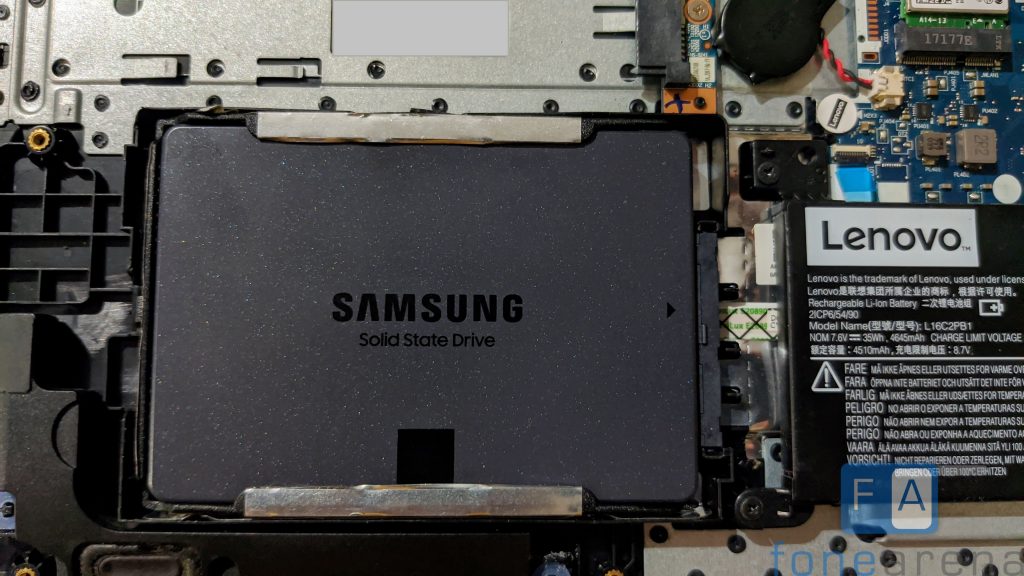
Let’s talk about the performance which is a crucial factor of an SSD. Just to recap the specifications, the 870 QVO 2TB model has the Samsung MKX Controller and has 4GB of LPDDR4 DRAM Cache memory. The Cache memory ranges from 1GB to 8GB depending upon the various storage sizes this SSD comes in i.e., up to 8TB. The claimed Sequential Read Speeds of the 870 QVO is up to 560MB/S and the Sequential Write Speeds of is up to 530MB/S. The Endurance is up to 2880 TBW (Terabytes Written) and in the model we reviewed which comes with 2TB capacity, the Endurance is 720 TBW which is lower than a TLC SSD. Samsung is offering limited warranty of 3-years or TBW, whichever comes first. Considering the competition in this segment comes with 5-years warranty, we expected Samsung to offer the same as well.
Tools used for benchmark
- Crystal Disk Mark
- ATTO
- Samsung Magician
- AS SSD
- IOMeter
- Shadow Bringers Final Fantasy XIV Benchmark
System Configuration
- Intel Core i5-7200 CPU clocked at 2.50 GHz
- 2GB NVIDIA GeForce 920MX GPU
- 8GB DDR4 RAM clocked at 2133 MHz
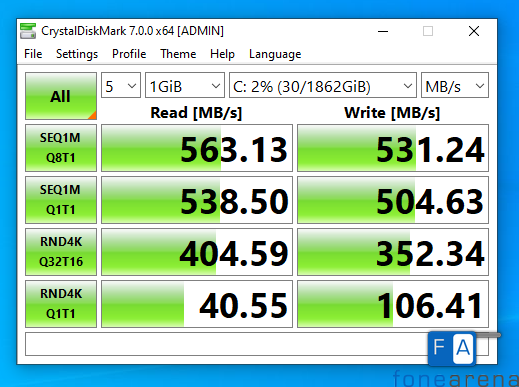

For the test, we ran benchmark tools like Crystal Disk Mark, ATTO, Samsung Magician, AS SSD, ATTO, and IOMeter. In Crystal Disk Mark, the Sequential Read speed was 563.13 MB/S and the Sequential Write speed was 531.24 MB/S. Further, the IOPS for read/write was 9917/25,935 MB/S, and for the uninitiated, IOPS (Input/Output Operations Per Second) measures the disk’s number of read and write operations per second.
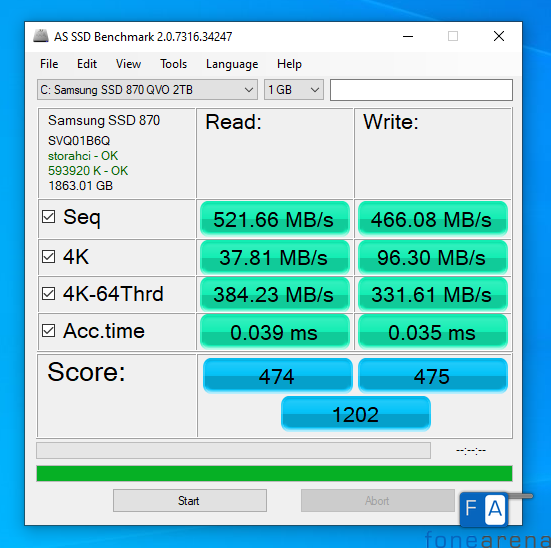

In AS SSD tool, the Sequential Read speed was 521.66 MB/S and the Sequential Write speed was 466.08 MB/S. In 4K-64 Thread measure i.e., testing the R/W performance of a random 4K Block at a queue depth of 64, the Samsung 870 QVO got a Read Speed of 384.23 MB/S and a write Speed of 331.61 MB/S. The IOPS for read/write was 98,362/84,891.
Moving on, to mimic the real-world game load times, we ran Shadow Bringers Final Fantasy XIV Benchmark. The total loading time was 32.404 sec and here is the breakup of the loading times by scene. (It is to be noted that the results might vary based on your system configuration).
Loading Times by Scene
- Scene #1: 3.602 sec
- Scene #2: 7.451 sec
- Scene #3: 9.868 sec
- Scene #4: 7.856 sec
- Scene #5: 3.627 sec
Total Loading Time: 32.404 sec
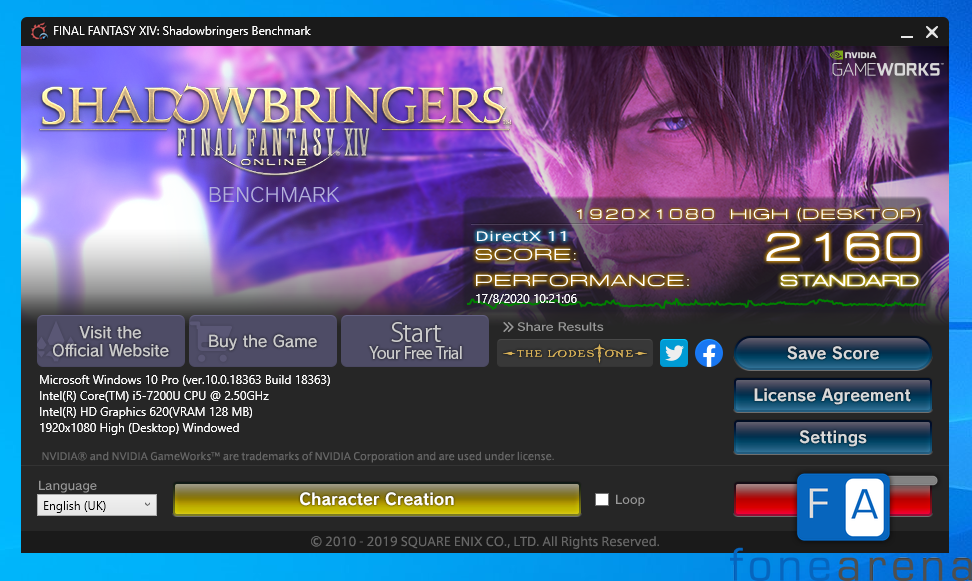
Apart from this, we also tested this SSD with IOMeter, a popular benchmark and troubleshooting tool. The test was done with ‘All in one Access Specifications’ and for the uninitiated, you can control the I/O each Worker performs in the ‘Access Specifications’ tab of IOMeter tool. The following were the ‘Global Access Specifications’ that was set for this test
- 512 B; 100% Read 0% Random
- 512 B; 75% Read 0% Random
- 512 B; 50% Read, 0% Random
- 512 B; 25% Read, 0% Random
- 4 KiB; 100% Read, 0% Random
- 4 KiB; 75% Read, 0% Random
- 4 KiB; 50% Read, 0% Random
- 4 KiB; 25% Read, 0% Random
- 4 KiB; 0% Read, 0% Random
- 4 KiB aligned; 100% Read, 100% Random
- 4 KiB aligned; 50% Read, 100% Random
- 4 KiB aligned; 0% Read, 100% Random
- 16 KiB; 100% Read, 0% Random
- 16 KiB; 75% Read, 0% Random
- 16 KiB; 50% Read, 0% Random
- 16 KiB; 25% Read, 0% Random
- 16 KiB; 0% Read, 0% Random
- 32 KiB; 100% Read, 0% Random
- 32 KiB; 75% Read, 0% Random
- 32 KiB; 50% Read, 0% Random
- 32 KiB; 25% Read, 0% Random
- 32 KiB; 0% Read, 0% Random
- 64 KiB; 100% Read, 0% Random
- 64 KiB; 50% Read, 0% Random
- 64 KiB; 0% Read, 0% Random
- 256 KiB; 100% Read, 0% Random
- 256 KiB; 50% Read, 0% Random
- 256 KiB; 0% Read, 0% Random
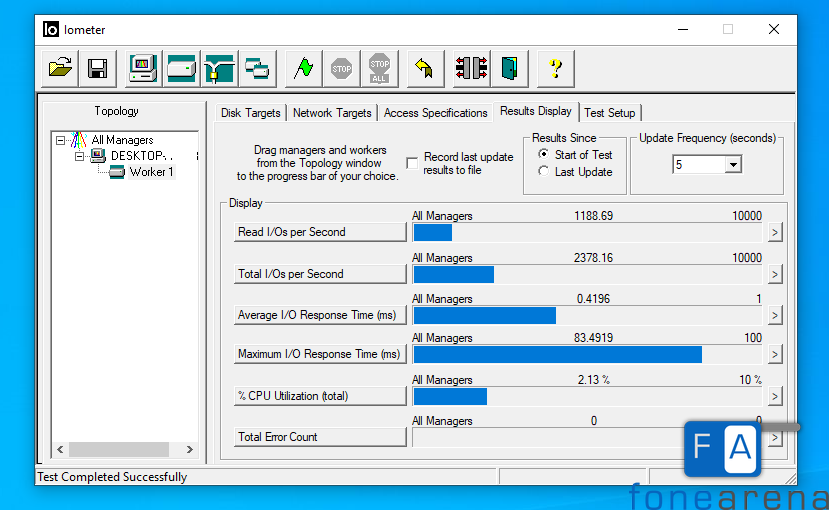
In this test, the Total I/Os per second was 2378.16, the Read I/Os per second was 1188.69, and the Write I/Os per second was 1189.47. The maximum I/O response time during the test was 83.4919 milliseconds, and the average I/O response time was 0.4196 milliseconds. The CPU Utilization during the test was low as well at 2.13%.
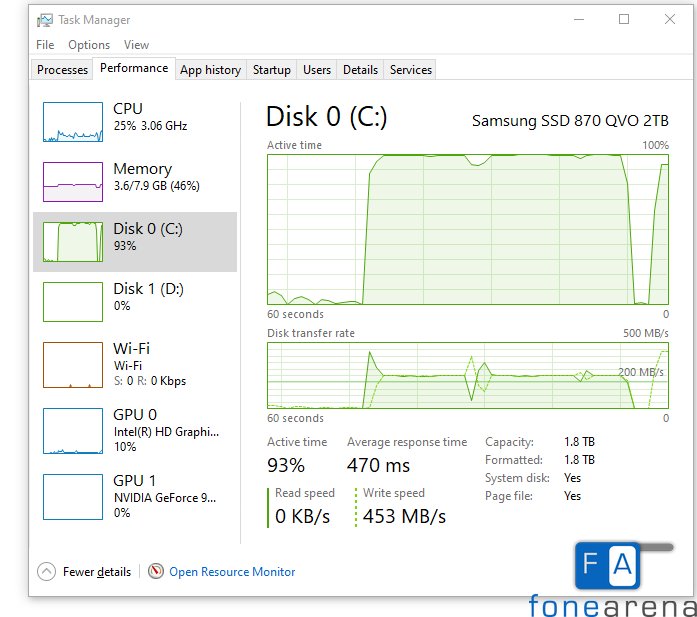
Coming to the real-world transfer test, firstly, we performed a 17.5 GB transfer containing 222 files and 20 folders. We got a peak Write speeds of 453 MB/S and the total transfer completed in 1 minute 30 seconds with an average response time of 470 milliseconds.
Moving on, the Samsung 870 QVO 2TB model features Samsung’s Intelligent TurboWrite that was seen on the last-gen 860 QVO as well. The way this works is, a write buffer area is created within the SSD which is a 6GB SLC and when the SSD is idle, the data from the buffer area is written on the main storage area. On the 870 QVO 2TB model, there is a 6GB SLC and up to 78GB dynamic cache. The dynamic cache is up to 78GB on the 4TB and 8TB models as well, but the 1TB model has slightly lower dynamic cache – up to 42GB.
Coming back to large file transfer tests, we tested the transfer speeds of a 492 GB file and the speeds when the cache got full was also measured. The total transfer took about 45 minutes and the transfer speeds were hovering around 375-385 MB/S until the cache got full. Post that, the speeds were around the 150 – 160 MB/S mark. That said, you might not do such huge transfers at one go often, but it is to be noted that you will get the almost claimed sequential read/write speeds until the cache gets full.
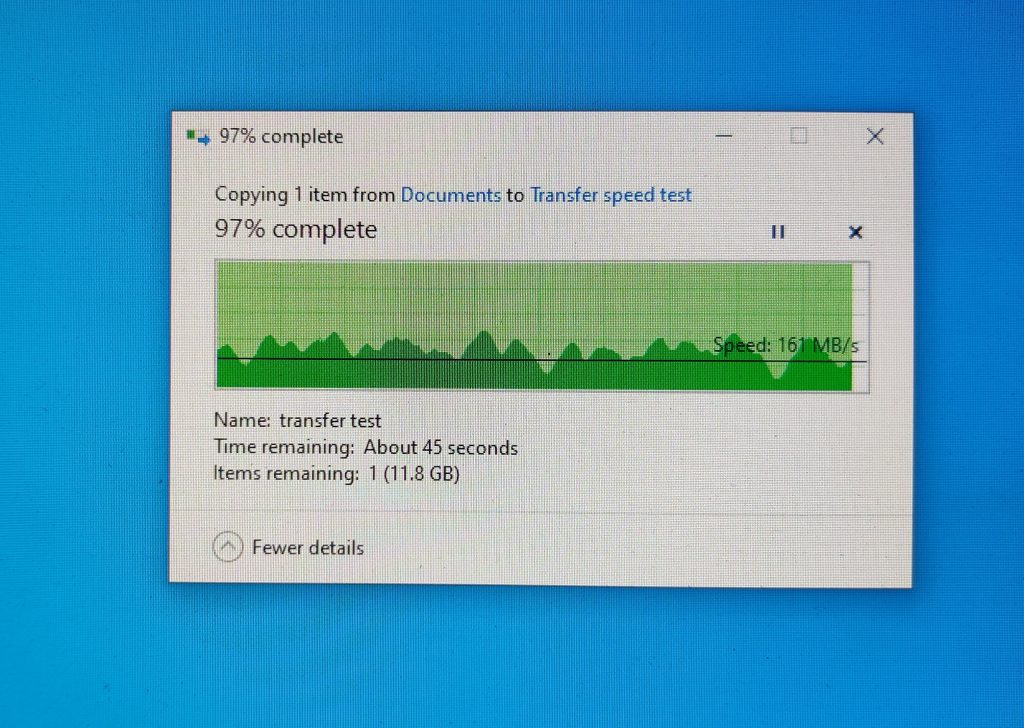
Lastly, the startup time from a cold boot was pretty fast as well on this SSD and in our testing, the system booted in less than 10 seconds which is pretty good, and it took around 2-3 seconds to shut down completely. Similarly, you shouldn’t have issues with application loading times for the most part with this 870 QVO SSD.
Software
The Q70 QVO can be managed with the Samsung Magician tool which has most of the basic features to manage your drive and data. Under the Drive Management tab, you have five different handy features – Drive Details, Performance Benchmark, Diagnostic Scan, Over Provisioning, and Performance Optimisation. The Diagnostic Scan feature lets you scan and fix any sorts of error on the disk and gives you 3 options – Short Scan, Full Scan, and SMART Self-Test which includes Short/Extended scans.
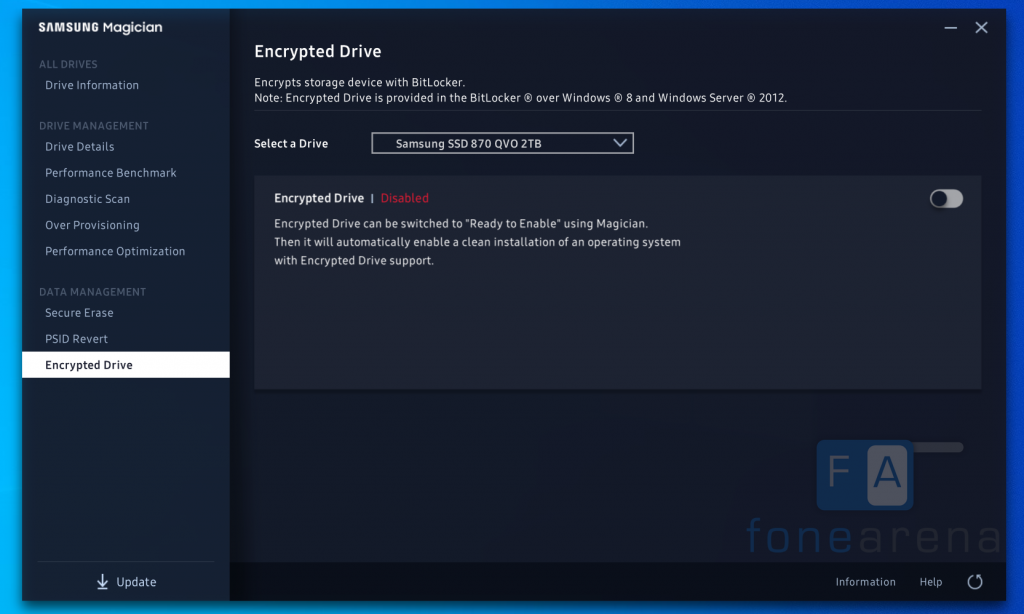
Under Data Management, you get 3 features – Secure Erase, PSID Revert (Physical Security ID), and the most interesting and nifty feature – AES 256-bit Encryption. It encrypts the SSD with BitLocker and you can easily enable or disable encryption, right from the Samsung Magician tool. This is something other SSDs in this segment do not have and the Samsung 870 QVO has an edge here.
Conclusion
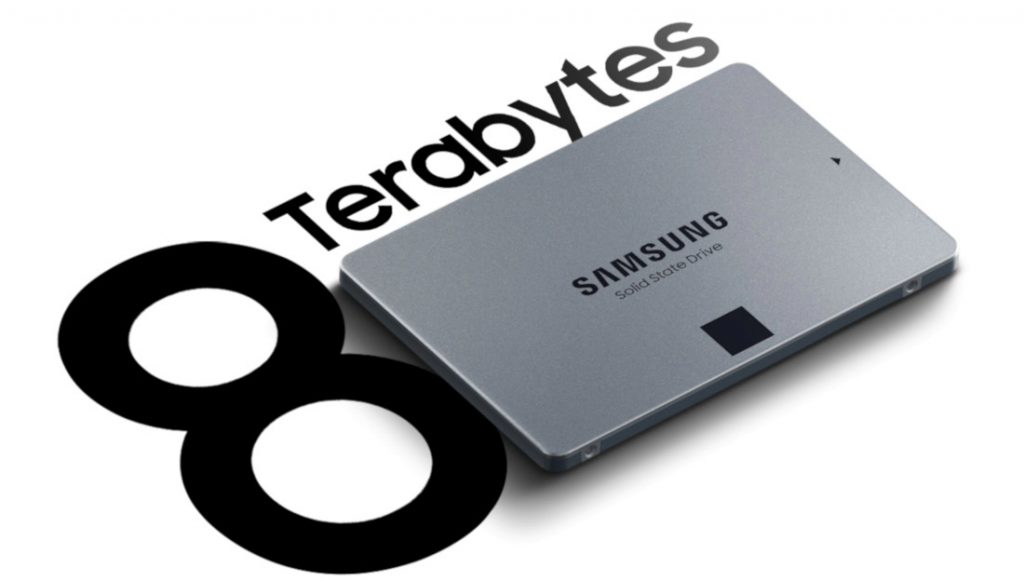
With the 870 QVO, Samsung has refreshed the QLC SATA SSD lineup with up to whopping 8 terabytes of capacity on a consumer-grade SSD, setting new benchmarks in the storage category, and at the same time, delivering a great performance as well. The 2TB model that we reviewed offers fast Read/Write speeds (until the cache is full) and introduces AES 256-bit Encryption which we hope more manufacturers add going further. While you will definitely get much faster Read/Write speeds with an M.2 SSD, the Samsung 870 QVO V-NAND QLC SSD offers much higher capacities for users wanting faster storage.
Overall, if you are in the market for a great performing higher capacity V-NAND SSD, the 870 QVO is highly recommended. If you want much faster Read/Write speeds, then you will be better off getting an M.2 SSD.
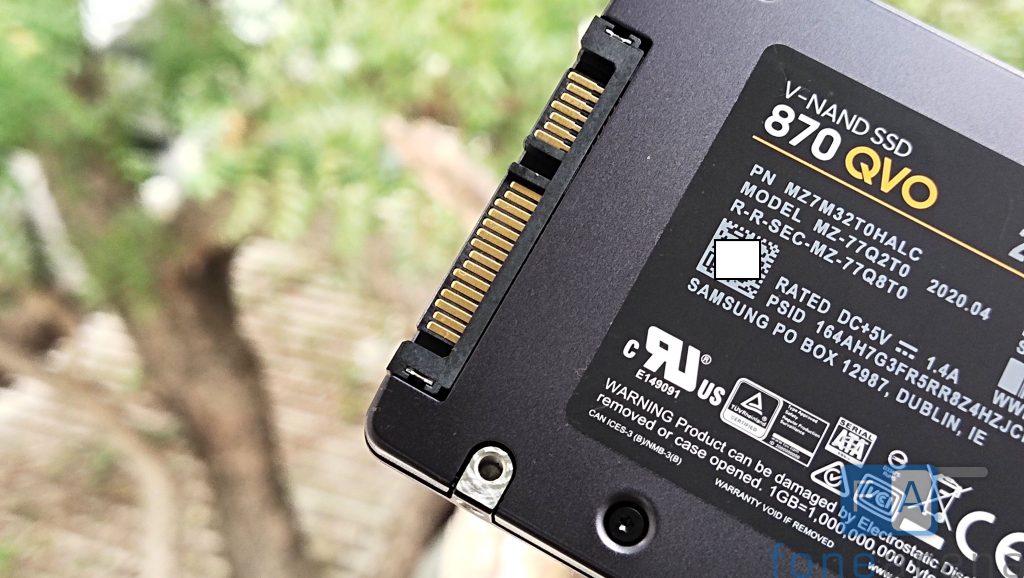
Pricing and availablility
The Samsung 870 QVO is priced at Rs. 9999 for the 1TB model, Rs. 19,999 for the 2TB model, Rs. 39,999 for the 4TB model, and Rs. 74,999 for the 8TB model. It is available to buy from Amazon.in, and Samsung India e-Store.
Pros
- Solid build quality
- Massive storage capacities up to 8 Terabytes
- Great performance
- AES 256-bit Encryption
- Higher-capacity variant offers more money-value proposition compared to other storage variants
Cons
- Limited 3-year warranty
- Endurance could have been better
- Quite steep drop in Write speeds once the cache is full
